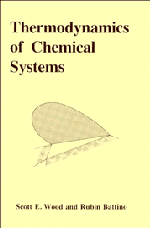Book contents
- Frontmatter
- Contents
- Preface
- Notation
- 1 Introduction
- 2 Temperature, heat, work, energy, and enthalpy
- 3 The second law of thermodynamics: the entropy function
- 4 Gibbs and Helmholtz energy functions and open systems
- 5 Conditions of equilibrium and stability: the phase rule
- 6 Partial molar quantities
- 7 Ideal gases and real gases
- 8 Liquids and solids: reference and standard states
- 9 Thermochemistry
- 10 Phase equilibrium
- 11 Chemical equilibrium
- 12 Equilibria in electrochemical systems
- 13 Surface effects
- 14 Equilibrium conditions in the presence of an external field
- 15 The third law of thermodynamics
- Appendices
- Cited references and selected bibliography
- Subject index
4 - Gibbs and Helmholtz energy functions and open systems
Published online by Cambridge University Press: 28 October 2009
- Frontmatter
- Contents
- Preface
- Notation
- 1 Introduction
- 2 Temperature, heat, work, energy, and enthalpy
- 3 The second law of thermodynamics: the entropy function
- 4 Gibbs and Helmholtz energy functions and open systems
- 5 Conditions of equilibrium and stability: the phase rule
- 6 Partial molar quantities
- 7 Ideal gases and real gases
- 8 Liquids and solids: reference and standard states
- 9 Thermochemistry
- 10 Phase equilibrium
- 11 Chemical equilibrium
- 12 Equilibria in electrochemical systems
- 13 Surface effects
- 14 Equilibrium conditions in the presence of an external field
- 15 The third law of thermodynamics
- Appendices
- Cited references and selected bibliography
- Subject index
Summary
The only two functions actually required in thermodynamics are the energy function, obtained from the first law of thermodynamics, and the entropy function, obtained from the second law of thermodynamics. However, these functions are not necessarily the most convenient functions. The enthalpy function was defined in order to make the pressure the independent variable, rather than the volume. When the first and second laws are combined, as is done in this chapter, the entropy function appears as an independent variable. It then becomes convenient to define two other functions, the Gibbs and Helmholtz energy functions, for which the temperature is the independent variable, rather than the entropy. These two functions are defined and discussed in the first part of this chapter.
Only closed systems have so far been considered. However, mass can be varied and is an important variable for all thermodynamic functions. The introduction of mass as an independent variable into the basic differential expressions for the thermodynamic functions yields the equations that Gibbs called ‘fundamental’. It is on these equations that much of the development of the applications of thermodynamics to chemical systems is based.
Many of the problems that are met in applications require the evaluation of various derivatives and the integration of differential quantities that involve the derivatives. To be of use, the derivatives must be expressed in terms of experimentally determinable quantities.
- Type
- Chapter
- Information
- Thermodynamics of Chemical Systems , pp. 47 - 63Publisher: Cambridge University PressPrint publication year: 1990



